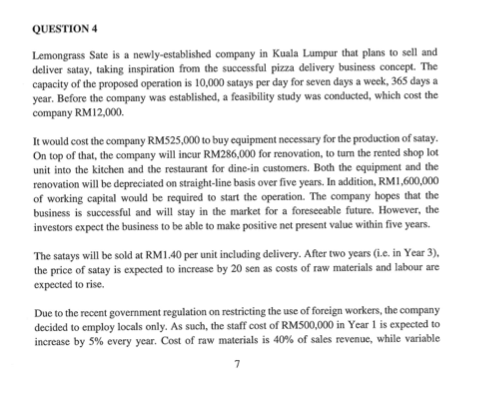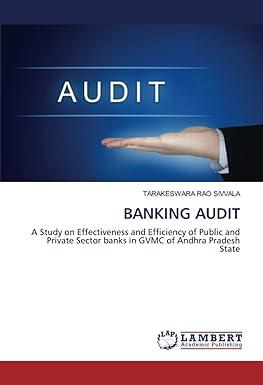

QUESTION 4 Lemongrass Sate is a newly established company in Kuala Lumpur that plans to sell and deliver satay, taking inspiration from the successful pizza delivery business concept. The capacity of the proposed operation is 10,000 satays per day for seven days a week, 365 days a year. Before the company was established, a feasibility study was conducted, which cost the company RM12,000 It would cost the company RM525,000 to buy equipment necessary for the production of satay, On top of that, the company will incur RM286,000 for renovation, to turn the rented shop lot unit into the kitchen and the restaurant for dine-in customers. Both the equipment and the renovation will be depreciated on straight-line basis over five years. In addition, RM1,600,000 of working capital would be required to start the operation. The company hopes that the business is successful and will stay in the market for a foreseeable future. However, the investors expect the business to be able to make positive net present value within five years. The satays will be sold at RM1.40 per unit including delivery. After two years (1.c. in Year 3). the price of satay is expected to increase by 20 sen as costs of raw materials and labour are expected to rise. Due to the recent government regulation on restricting the use of foreign workers, the company decided to employ locals only. As such, the staff cost of RM500,000 in Year 1 is expected to increase by 5% every year. Cost of raw materials is 40% of sales revenue, while variable 7 overheads will amount to 30 sen per unit. The shop lot unit is rented at RM74.000 per year. Other fixed overheads will be RM150,000 per annum, and is expected to increase by 10% every year. It is expected that after five years, the company will move out from the current shop lot unit to a bigger space to cater the increase in demand. The equipment can be sold for RM30,000, and another RM42,000 will be incurred to restore the building to its original condition as per the rental agreement. The company pays income tax at the rate of 24%. Capital allowance (i.e. tax depreciation) is available only for the equipment, and is calculated at the rate of 40% on cost in the first year and 20% in each of the three subsequent years. The company's cost of capital is 12%. Required: a) Determine the cash flow pattern on the business over the five-year period. Round your answer to the nearest whole number. (18 marks) b) Calculate the net present value of the business. Should the company continue with the plan to sell and deliver satay? (3 marks) c) There is no such thing as capital rationing. What is your view on this statement? Discuss. (4 marks) [TOTAL: 25 MARKS] QUESTION 4 Lemongrass Sate is a newly established company in Kuala Lumpur that plans to sell and deliver satay, taking inspiration from the successful pizza delivery business concept. The capacity of the proposed operation is 10,000 satays per day for seven days a week, 365 days a year. Before the company was established, a feasibility study was conducted, which cost the company RM12,000 It would cost the company RM525,000 to buy equipment necessary for the production of satay, On top of that, the company will incur RM286,000 for renovation, to turn the rented shop lot unit into the kitchen and the restaurant for dine-in customers. Both the equipment and the renovation will be depreciated on straight-line basis over five years. In addition, RM1,600,000 of working capital would be required to start the operation. The company hopes that the business is successful and will stay in the market for a foreseeable future. However, the investors expect the business to be able to make positive net present value within five years. The satays will be sold at RM1.40 per unit including delivery. After two years (1.c. in Year 3). the price of satay is expected to increase by 20 sen as costs of raw materials and labour are expected to rise. Due to the recent government regulation on restricting the use of foreign workers, the company decided to employ locals only. As such, the staff cost of RM500,000 in Year 1 is expected to increase by 5% every year. Cost of raw materials is 40% of sales revenue, while variable 7 overheads will amount to 30 sen per unit. The shop lot unit is rented at RM74.000 per year. Other fixed overheads will be RM150,000 per annum, and is expected to increase by 10% every year. It is expected that after five years, the company will move out from the current shop lot unit to a bigger space to cater the increase in demand. The equipment can be sold for RM30,000, and another RM42,000 will be incurred to restore the building to its original condition as per the rental agreement. The company pays income tax at the rate of 24%. Capital allowance (i.e. tax depreciation) is available only for the equipment, and is calculated at the rate of 40% on cost in the first year and 20% in each of the three subsequent years. The company's cost of capital is 12%. Required: a) Determine the cash flow pattern on the business over the five-year period. Round your answer to the nearest whole number. (18 marks) b) Calculate the net present value of the business. Should the company continue with the plan to sell and deliver satay? (3 marks) c) There is no such thing as capital rationing. What is your view on this statement? Discuss. (4 marks) [TOTAL: 25 MARKS]








